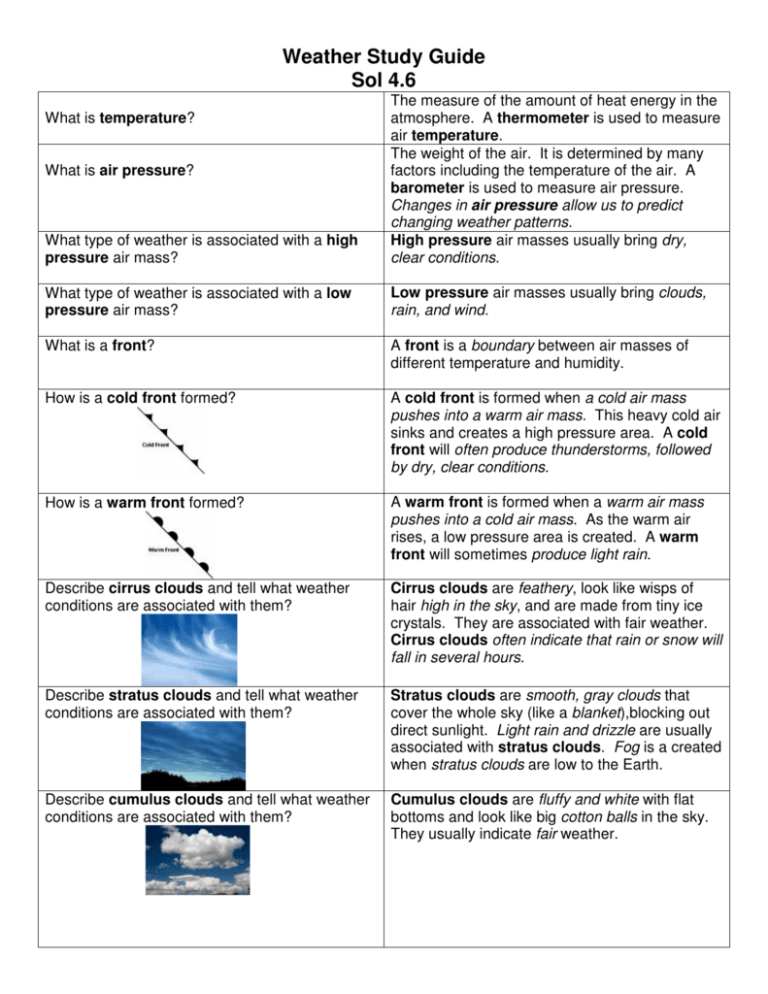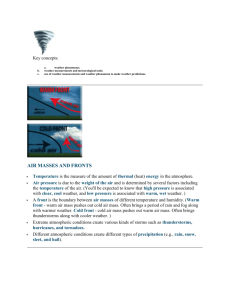Weather Study Guide Sol 4.6
advertisement

Weather Study Guide Sol 4.6 What type of weather is associated with a high pressure air mass? The measure of the amount of heat energy in the atmosphere. A thermometer is used to measure air temperature. The weight of the air. It is determined by many factors including the temperature of the air. A barometer is used to measure air pressure. Changes in air pressure allow us to predict changing weather patterns. High pressure air masses usually bring dry, clear conditions. What type of weather is associated with a low pressure air mass? Low pressure air masses usually bring clouds, rain, and wind. What is a front? A front is a boundary between air masses of different temperature and humidity. How is a cold front formed? A cold front is formed when a cold air mass pushes into a warm air mass. This heavy cold air sinks and creates a high pressure area. A cold front will often produce thunderstorms, followed by dry, clear conditions. How is a warm front formed? A warm front is formed when a warm air mass pushes into a cold air mass. As the warm air rises, a low pressure area is created. A warm front will sometimes produce light rain. Describe cirrus clouds and tell what weather conditions are associated with them? Cirrus clouds are feathery, look like wisps of hair high in the sky, and are made from tiny ice crystals. They are associated with fair weather. Cirrus clouds often indicate that rain or snow will fall in several hours. Describe stratus clouds and tell what weather conditions are associated with them? Stratus clouds are smooth, gray clouds that cover the whole sky (like a blanket),blocking out direct sunlight. Light rain and drizzle are usually associated with stratus clouds. Fog is a created when stratus clouds are low to the Earth. Describe cumulus clouds and tell what weather conditions are associated with them? Cumulus clouds are fluffy and white with flat bottoms and look like big cotton balls in the sky. They usually indicate fair weather. What is temperature? What is air pressure? Describe cumulo-nimbus clouds and tell what weather conditions are associated with them? What is precipitation? How is rain formed? How is snow formed? How is sleet formed? How is hail formed? Cumulo-nimbus clouds are formed by cumulus clouds that join together. They become so full of moisture, they turn dark and heavy, often resulting in thunderstorms with heavy rains, thunder, and lightning. Precipitation is any form of water that falls from the atmosphere to Earth’s surface. Precipitation is measured with a rain gauge. Precipitation includes rain, snow, sleet, and hail. Water vapor in the atmosphere condenses, changing from gas to liquid. These liquid water droplets become too heavy and fall to the ground. Snow is formed when the water droplets in the clouds freeze high in the atmosphere, forming ice crystals. These ice crystals attach to each other and become heavier. When they weigh too much, they fall to the ground as snow. Sleet is formed when ice crystals fall, but the air temperature is just above freezing, so some of the ice crystals melt and some remain frozen. Hail is formed when raindrops are frozen into crystals in a storm cloud. Winds produced by the storm cause the frozen ice crystals to repeatedly rise and fall, melting and freezing again. This causes layers of ice to form around the original ice crystal. When it becomes very heavy, it falls as a ball of ice. How are hurricanes formed and what type of weather is associated with them? Hurricanes are formed when small thunderstorms over the ocean grow larger as they take in more and more heat and moisture from the warm ocean water. They have strong winds that move in huge circles. Hurricanes are the largest storms on Earth! How are tornadoes formed and what type of weather is associated with them? Tornadoes are formed during thunderstorms as a column of warm air begins to spin upward forming a funnel cloud. A tornado is MUCH SMALLER than a hurricane. Tornadoes have extremely strong circular winds and can be the most violent type of storm. What is a meteorologist? A meteorologist is a person who gathers data about weather using a variety of instruments. What does a barometer measure? air pressure wind speed What does an anemometer measure? precipitation What does a rain gauge measure? temperature of the air What does a thermometer measure?







